|
It is sometimes hard to imagine a scene like the one shown above:
the first ray of dawn on Memorial Day weekend at Furnace Creek Ranch in
Death Valley, where dozens of birders have been sleeping on the golf course
and are now awakening to see what eastern vagrants the day will bring.
Today, in the 21st Century and three decades later, Furnace Creek Ranch
is posted and fenced and patrolled; the only places to sleep are the $110/night
motel rooms. Now, the few birders who might show up must get off the course
before the first golfer appears. But the photo captured a typical scene
of how things used to be, when birding was a social sport of eager participants
who were pushing the frontiers of bird identification and distribution
as fast as they could.
|
|
It is also hard to recreate the scene below: another Memorial Day
weekend, this one at Oasis ranch in Mono County, California. Back in those
days the ranch watered the rows of cottonwoods, and birding access was
possible. On holiday weekends each spring and fall there would be dozens
of birders present, working the trees after driving from San Francisco
or Los Angeles to join in this unorganized yet somehow ritual group endeavor.
|
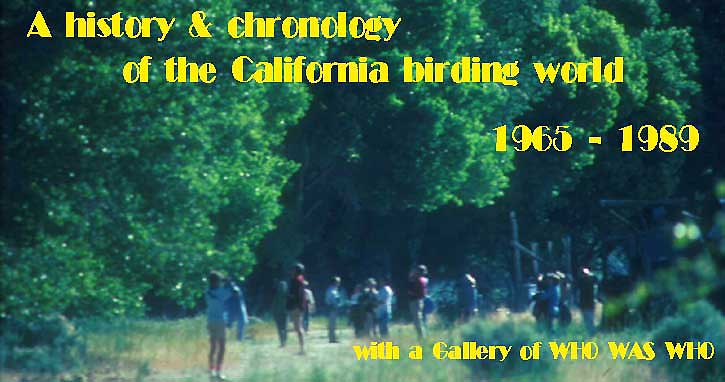
Top photo: dawn 25 May 1975 Furnace Creek;
next photo 29 May 1978 Oasis, both © D. Roberson
|
The quarter century between 1965-1989 represents only part of the on-going
history of California birding, but distinctive events mark the boundaries
in 1965 and 1989:
-
In 1965, Guy McCaskie became the sole regional editor for the "Southern
Pacific Coast" Region of Audubon Field Notes, which was to become
American
Birds (1971), then Field Notes (1994), and then finally North
American Birds (1999). He has held that position ever since. [This
begins our 25 year period although, for practical purposes, the fall of
1964 is often included.] 1965 was also the year Point Reyes Bird Observatory
in Marin County in northern California was established. Thus for both north
and south, 1965 is a watershed starting point.
-
In 1989, the California Bird Records Committee (CBRC) completed
its "old records review" project and, with the new decade, some 92% of
all historic reports of California rarities had been reviewed. Within a
year, the CBRC Secretary who oversaw this project would retire and a significant
'changing of the guard' at the CBRC began. Through the 14th CBRC report,
which summarized the "old records review" project, ten CBRC members had
authored or co-authored CBRC reports. Thereafter, as many "new" names appeared
as authors of CBRC reports in the 1990s as had been involved in the previous
two decades combined. The start of this 'changing of the guard' within
the CBRC is a convenient end-point to the quarter century considered here.
|
|
|
| The quarter century from 1965 to 1989 witnessed the initiation and
rise of two important organizations and their publications, which melded
with the pre-existing publication
Audubon Field Notes (above
left, top row), sponsored by National Audubon Society. The latter journal
would, over time, become American Birds (in 1971), go to
color covers (1975) and increase in size (1979) before sputtering and down-grading
to
Field Notes (1994). This important journal would rebound as North
American Birds (1999), and is now published by the American Birding
Association (ABA). Throughout the years the journal published quarterly
seasonal summaries of birds of interest in California's two Regions (essentially,
northern and southern California; formal boundary adjustments in the mid-1990s
eventually accomplished a clean division between north and south).
The two new organizations were
California Field Ornithologists
(CFO) and the American Birding Association (ABA). CFO was organized
in 1969 and went public in 1970 with its journal California Birds
(above left, bottom row). In 1973, the organization changed its name to
Western
Field Ornithologists, and its journal became Western Birds.
The journal publishes peer-reviewed papers on the status, distribution,
identification, and conservation ecology of birds in western North America;
the journal went to color covers in 1981 and has remained similar in format
under long-time editor Phil Unitt. The American Birding Association
(ABA) began as a national bird club in 1968. It changed its name to "American
Birding Association" in 1969 and began publishing
Birding magazine
that year (above; right-hand set). The initial mimeographed sheets became
a journal by Vol. 3 (1971) and had a color cover with standard logo by
Vol. 3, No. 6 (1971). All covers were color by 1979, and the magazine's
dimensions increased in 1989 and again in 1995. Today it is a glossy all-color
magazine. Once aimed at the "sport" of birding, with emphasis on lists,
finding life birds, and competitions (e.g., Big Days, Big Years), the organization
first evolved toward more bird identification and bird-finding papers than
articles about listing. As the membership grew, the founders lost control
of the organization and the emphasis changed again, now focussing on beginning
and intermediate birders. At present, papers on identification still appear
but topics now include equipment, etiquette, conservation, and aesthetics.
Many of those chosen for California's "top 40" during the period under
review were involved in one or more of these publications by authoring
papers, editing, or serving on the boards of the organizations. |
| By the early 1980s, birders on the 'Death Valley loop'
had found a store in Dyer, Nevada, that had cold drinks in the middle of
a hot afternoon. Enjoying a brief rest on 30 May 1982 are (L to R) John
Sterling, Phil Swan, Paul Lehman, Richard Webster, Laurie Klaisle, Guy
McCaskie, Jerry Oldnettle, John Luther, David Luther (the boy in red hat),
Jolee DeLew, and two unidentified. |
|
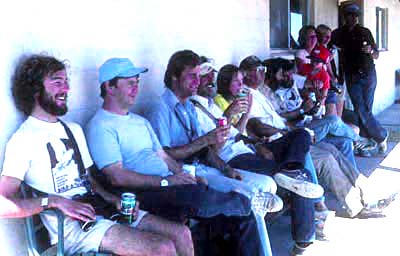 The
decades of the 1960s, '70s, and '80s were years of abundant change in the
birding world. Birdwatching as an active hobby became increasingly popular
throughout the period and multitudes were actively birding by 1990 where
there had been but a few in 1965. Those who influenced this period and
helped define and direct its changes are those who are considered here
for "TOP 40" list of WHO WAS WHO in California birding during
this quarter-century. The
decades of the 1960s, '70s, and '80s were years of abundant change in the
birding world. Birdwatching as an active hobby became increasingly popular
throughout the period and multitudes were actively birding by 1990 where
there had been but a few in 1965. Those who influenced this period and
helped define and direct its changes are those who are considered here
for "TOP 40" list of WHO WAS WHO in California birding during
this quarter-century.
|
GO TO
|

|
1965-1989 |
Some important observers had influence for only a comparatively short
time, including several early in the period: Paul DeBenedictis, Pierre
Devillers, Ted Chase, Joe Greenberg (and his sons Doug & Russ), Bob
Paxton, Bob Pyle, Eleanor A. Pugh, and Shirley Wells. Others became important
in the mid to late 1980s, including Kurt Campbell, Curtis Marantz, and
many who would become CBRC members in the '90s: Shawneen Finnegan, Robb
Hamilton, Matt Heindel, Steve Howell, Al Jaramillo, Michael Patten, Mike
Rogers, Stephen C. Rottenborn, Mike San Miguel, and Dan Singer. It was
difficult choosing 40 observers (well, er, actually 41 with Herb &
Olga Clarke in one slot) who had influence over large portions of the quarter-century
without adding those whose impacts were of a shorter duration.
|
|
In the 1970s, birders on the 'Death Valley loop'
often camped at an informal campsite along Cottonwood Creek, straddling
the Inyo-Mono county border, and dinner was what you brought with you.
Here's a typical birder dinner in those days — Dinty Moore stew
or Dennison's chile heated on the fire. In the background are Brad
Schram (yellow shirt) and Paul Lehman (blue T-shirt).
|
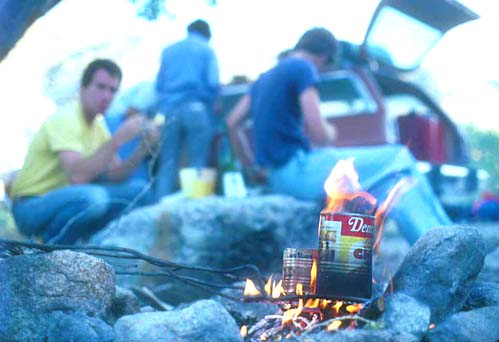
|
| In choosing a "top 40" gallery of influential birders, the choices
are meant to illustrate those with a statewide impact for a significant
period. Those having an impact for at least half the quarter-century —
at least 12 years — were strongly preferred. Only 3 of the 40 had a shorter
tenure within California during our period of review (Van Remsen, Peter
Pyle, John Sterling), and each of these were actively birding in the State
for at least 10 years, and each has unique achievements that warrant their
inclusion.
Any list is subjective. Those in the top two or three rows of my gallery
are obvious shoo-ins, but for other choices some consideration was given
to that person's innovations that affected the birding community, or one's
influence as a mentor for others. Besides Guy McCaskie and Rich Stallcup,
several choices here honor those who were important mentors in the California
bird world, including Laurie Binford, Van Remsen, Alan Baldridge, Tim Manolis,
Elizabeth Copper, and Jeri Langham. A person was automatically included
on this list if they met at least two of the following criteria
during
our period of review:
-
Authored or edited a major publication of significance to California (e.g.,
major field guide, state or regional book, major identification paper);
-
Served as the California
Bird Records Committee [CBRC] secretary during the period;
-
Served multiple terms on the CBRC during the period (or, since the early
CBRC did not have 'terms,' served at least 4 years during the period);
-
Authored a CBRC report during the period;
-
Served as an
AFN/AB/NAB
Regional Editor for southern or northern California for a significant
period (12 or more seasons = 3+ years) during the period;
-
Personally discovered a number of major California rarities;
-
Discovered or first popularized one or more major California birding sites;
-
Received the anonymously awarded "Bob
Smart ticky token" from ABA, for a birding achievement [these were
only awarded in the 1980s];
-
Was given an
"official" bird name in the late 1970s, a token reserved for hardcore,
dedicated birders; or
-
Was listed among the top
three California state listers during the period.
|
| Because these choices were those with statewide influence, not primarily
county or regional impacts, the field was considerably narrowed. If one
were to consider the impact of regional or county birders, those names
that spring quickly to mind include (north to south): Stan Harris, Gary
Lester, Alan Barron, Tom Schulenberg, Craig Hohenberger, Dave Rudholm (northwest
CA); Ray Ekstrom, Mike Robbins (northeast CA); Bruce Deuel, Bob & Carol
Yutzy, Kent Van Vuren (n. Sacramento Valley); Ed Harper, Ed Greaves (Sacramento
area), Gordon Bolander, John Parmeter (Sonoma, Napa counties); C.J. Ralph,
Jules Evens, and Keith Hansen (Marin Co.); Richard Tenaza, Henry Robert,
John Smail, and Phil Henderson (Farallon Islands); Howard Cogswell, Art
Wang, Jean Richmond, Bob Richmond, Art Edwards, Mary L. Rosegay, Bruce
Barrett, and Kurt Campbell (S.F. Bay region); Peter Metropulos, Barry Sauppe
(San Mateo Co.; Metropulos also in Mono Co.); David Suddjian, Randy Morgan
(Santa Cruz Co.); Ron Branson, Bill Reese, Laidlaw Williams (Monterey Co.);
Dave Yee, Rob Hansen, Bob Barnes (San Joaquin Valley & Kern Co.); Tom
Edell, Curtis Marantz (San Luis Obispo Co.); Larry Sansone, Mike San Miguel,
Hal Baxter, Clyde Bergman, Hank & Priscilla Brodkin, Art & Jan
Cupples, and many more (greater L.A. vicinity); Brian Daniels and Doug
Willick (Orange & San Diego counties); Steve Cardiff (San Bernardino
& Riverside counties); and Tom & Jo Heindel (Inyo Co.). There were
also a number of people with wide importance in the fields of bird population
survey work or on endangered species, including Joe Jehl, Stephen A. Laymon,
Gary Page, Lynne Stenzel, Brian Walton, and John & Ricky Warriner,
to name just a few.
Whether or not to include me — surely the most subjective of choices
— was an issue. In the end I decided to play Forrest Gump in this
history, appearing as my self amongst the backdrop of the period. I do
meet 8 of the 10 criteria enumerated above (and would meet the 9th and10th
— lengthy stint as North American Birds regional editor, listed
among top 3 State listers — in the 1990s, after the close of our period
of review)
— Don Roberson
|
|
GO TO
|

|
IN 1965-1989 |
All photos © to photographers listed on each person's linked page;
all rights reserved. |
|
ACKNOWLEDGMENTS
I am very grateful to the many photographers who contributed to this
project, but particularly wish to thank Barry Clark, Van Remsen, and Brad
Schram for digging in their archives for people pictures during the era
under review. I have been compiling California bird photos for many years,
and many of the shots come from that collection, while others were graciously
sent for this specific project.
I am also grateful to those who commented on earlier drafts of these
pages and made many helpful suggestions: Rita Carratello and Brad Schram
read and edited almost the entire text, adding immeasurably to its readability.
Additional valuable comments were forwarded by Laurie Binford, Terry Clark,
Alan Craig, Paul Lehman, Joe Morlan, Dan Singer, and Jon Winter. Many others
answered specific questions about people or events as the pages were created.
Despite this indispensable editing, however, I fear that errors and mistakes
still persist, and I welcome additional comments. A nice feature about
web projects is that they are easily corrected.
The opinions expressed herein are my own, and represent only one person's
'reality.' Others will have different views on various topics covered here.
|
|
| TOP
TO HOME PAGE
TO MONTEREY COUNTY
PAGE
TO CREAGRUS
CALIFORNIA LIST PORTAL PAGE
TO BIRD FAMILIES
OF THE WORLD
|
|
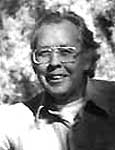
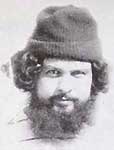
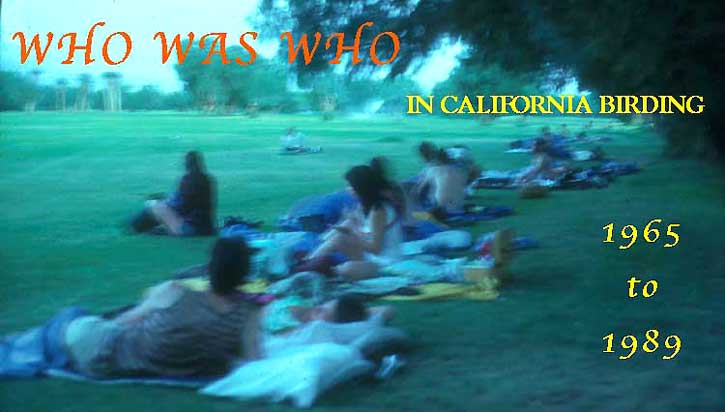

 The
decades of the 1960s, '70s, and '80s were years of abundant change in the
birding world. Birdwatching as an active hobby became increasingly popular
throughout the period and multitudes were actively birding by 1990 where
there had been but a few in 1965. Those who influenced this period and
helped define and direct its changes are those who are considered here
for "TOP 40" list of WHO WAS WHO in California birding during
this quarter-century.
The
decades of the 1960s, '70s, and '80s were years of abundant change in the
birding world. Birdwatching as an active hobby became increasingly popular
throughout the period and multitudes were actively birding by 1990 where
there had been but a few in 1965. Those who influenced this period and
helped define and direct its changes are those who are considered here
for "TOP 40" list of WHO WAS WHO in California birding during
this quarter-century.
